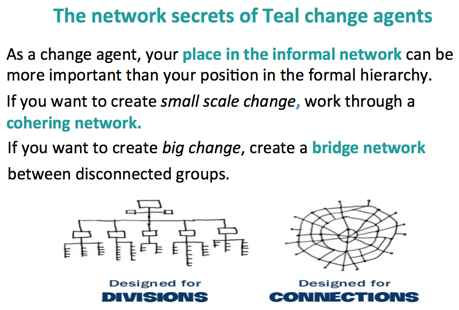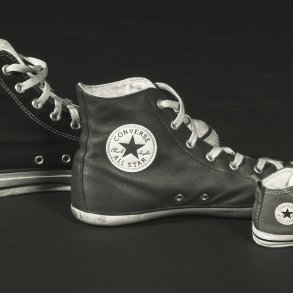By George Pór for Enlivening Edge Magazine
Introduction by Jean-Paul Munsch, Guest Editor of EE Magazine’s Education edition:
If you ever wondered what Teal embodiment could mean and asked yourself how it might look in an MBA academic 2-day-workshop, then we have a splendid answer for you here. Thought through from the student’s preparation to masterful “dotted” questions, George Pór designed a beautiful fractal pattern to develop sustainable co-creative work.
A heartfelt invitation for you to tune into.
This is more than a report on the workshop I designed and ran in a business school two years ago. It is an invitation for interested, Teal-inspired academics to further develop my “proof-of-concept” workshop into an open-sourced prototype that can be plugged in and replicated in any Masters’ Degree in Business Administration program that has future-responsive leadership.
You will find four sections below.
- The concept and motivation of my workshop inspired by the key themes and findings of Reinventing Organizations, held at the Management Centre, Innsbruck, Austria, February 6-7, 2015.
- The preparation of the workshop, including the pre-workshop assignments given to the students.
- What happened during the workshop and how to make it replicable, including some of the teaching aids used.
- The envisioned journey ahead from a proof-of-concept to a prototype, including next steps.
1. Concept & Motivation
The task I gave myself was to design and deliver a workshop that would not be only about “Teal Organizing”, but would also embody as many of its principles as the 2-day event’s design could carry. I chose to do so because Teal is not a thing, not a management technique that can be learned by reading or listening to talks about it. It’s a stage of consciousness that can only be experienced and inspired. As you know, learning from experience can go deeper and become transformative learning more easily than absorbing ready-made knowledge.
What drove me to create that workshop was a 4-fold motivation:
- Discover how a Teal-inspired educational design might work in a MBA class.
- Develop a proof-of-concept for a replicable prototype for such workshop.
- Observe and learn from the experience, to refine the design criteria for the prototype.
- Lay foundations for building a network of business educators who want to use the prototype and enhance it with their own focus and perspective.
2. Preparation
The 33 students of the class were working managers or future managers. The pre-workshop assignments they received by email were to:
- Read the “Structures, Practices, and Cultures” part of Frederic Laloux’s book Reinventing Organizations.
- Watch the summary or full version of video recording of Laloux’s talk in London (22 Jan 2015).
- Write down and send me any question emerging from step 1 and 2, which mattered to you the most, as well as, what challenges would you anticipate, if you wanted to introduce any of the Teal innovations in your organization.
3. What happened in the workshop
 The design of the workshop was built on the U Process of “Presencing, a social technology of freedom” developed by Otto Scharmer at MIT. See diagram on the left. The boldface phrases below refer to the cycles of the U Process.
The design of the workshop was built on the U Process of “Presencing, a social technology of freedom” developed by Otto Scharmer at MIT. See diagram on the left. The boldface phrases below refer to the cycles of the U Process.
In the Co-Sensing cycle, the class jointly developed an “issues list” by each student answering this question: If you would like to, and could change one thing at your workplace, supported by our collective intelligence here, what would that be? They collaboratively ranked these personally-experienced pain points of their respective organizational culture, by the importance they attributed to each. We heard:
About the present paradigm
- “The company I am working for is very performance- and achievement-driven. I assume it would take an entirely new leadership approach to foster this kind of wholeness in my company.”
- “My work-related tasks and my daily work are predominately affected by hard targets and performance goals. Work-life balance or personal thoughts or sensitivities are not taken into consideration.”
What motivation can drive change
- “I think a good mixture of soul is needed in an organization; humanity should not be forgotten.”
- “How can I consider in my decisions, that the bank is an organization where living people are working, and that their problems cannot always be seen under ‘financial glasses’?”
We also sensed into whether there some positive, Teal-leaning examples that people in the classroom have some experience with, building on the following pieces of student pre-work.
Positive experiences with the new paradigm
- “As we have to react very fast to the market and as all employees truly believe in the business idea, we are all quite engaged at work. Our leaders truly believe in self-management. Everyone has their own responsibilities and has to make decisions based on inner standards and without a lot of control. We have still some hierarchy, but within my department self-management and entrepreneurial thinking becomes increasingly important.”
- “It is good that our organization is somehow a soulful organization. Employees mostly care about each other, help each other, and do not compete or focus fully on their career.”
In the phase of Co-Presencing the future, we used a World Café format, where the top-ranked 6 items of the issues list became the focus for 6 tables in the first round of the Café conversations. It was the practical work in the second round of the Café and each group’s preparation of a presentation on their findings, which created some common ground for the three main groups of the students: those who were skeptical, or confused, or inspired from the very beginning of the workshop.
We started the second day of the workshop with a review of the following two principal business benefits of Teal organizing and what factors make them possible.
- Liberating previously unavailable energies
- Harnessing and directing organizational energies with more clarity and visions
We also addressed how to organize for change in the conversation ensuing from this slide:

That was followed by a group discussion on where should we go from here, based on what we discovered so far. We used the holacractic principle of “dynamic steering” that requires real data and rapid feedback. Both the data on where they were, and feedback on where they want to go next, were provided by the students themselves, in real time.
The choice made was about entering the Co-prototyping phase, by developing their action plan for implementation of the insights gained from the workshop, on which we spent the bulk of day 2.
The last group practice was the preparation for the Co-evolving phase, by formation of teams around the post-workshop group assignments.
That was followed by a group discussion on where should we go from here, based on what we discovered so far. We used the holacractic principle of “dynamic steering” that requires real data and rapid feedback. Both the data on where they were, and feedback on where they want to go next, were provided by the students themselves, in real time.
The choice made was about entering the Co-prototyping phase, by developing their action plan for implementation of the insights gained from the workshop, on which we spent the bulk of day 2.
The last group practice was the preparation for the Co-evolving phase, by formation of teams around the post-workshop group assignments.
We ended the workshop with a conversation not on what we learned individually, but what the collective “we” learned today. That was a significant stretch for most students because shifting to sense and think from “we” instead “me” is not what a typical MBA curriculum prepares them for. Yet, for self-management-based coordination to succeed, members of the organization have to learn to hold multiple perspectives.
Given the growing popularity of self-management in business, educating for flexible perspective-shifting needs to be part of any Teal course in business schools.
The “what did the we” learn exercise is also a requisite to develop the distinction between a community of learners (for the benefit of only the individuals) to a community that learns (for the benefit of the encompassing whole including the individuals).
4. From a proof-of-the-concept to a prototype
This workshop was a first experiment in creating an academic program introducing a Teal-inspired experience design. After the workshop, the students completed their group assignments that included writing a mini-”case study” about companies that have a leading edge organizational culture in their country, and building an annotated video knowledge base featuring excerpts from videos about organizations with a Teal culture from around the world.
This was only a proof-of-the-concept for a Teal-inspired pedagogy of teaching Teal concept in an MBA course. It provided many lessons for the journey ahead from this first experiment to a full-blown workshop prototype that can be replicated and open-sourced. If that possibility speaks to you, feel free to contact me at george(at)enliveningedge(dot)org.
If, by now, there are more of us Teal-inspired instructors out there, why not use this report also as a conversation-starter around creating a community of practice focused on educating the business leaders of the future, leaders who will know how to facilitate the emergence of more soulful organizations, “inspired by the next stage of human consciousness” (Frederic Laloux).

George Pór is an evolutionary thinker and a strategic learning partner to visionary leaders in business, government, and civil society. He is the originator of Enlivening Edge, and has been publishing the Blog of Collective Intelligence since 2003. A select list of his articles and book chapters on the fields of collective intelligence, organizational and social renewal can be found here. More about George’s work on the enlivening edge of planetary transformation is here.





Thanks for sharing this. I first encountered Teal through a presentation for MBA alumni (Open University, UK), and it has been singularly responsible for my transition into (nearly!) full-time academia and my current research project. Am listening (and learning) within this space with great interest and hope …
I’m really interested in this George and would love to know more about what happened and how the students experienced this. Had the design evolved and been run again since?